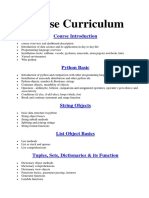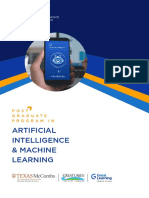Datascience Syllabus PDF
Uploaded by
Lakshmi MadavanDatascience Syllabus PDF
Uploaded by
Lakshmi MadavanDATA SCIENCE
TRAINING COURSE CONTENT
INTRODUCTION - 24 HOURS
BATCH LAUNCH Intro to Program | Curriculum Overview | Learning Methodology | Guest Lecture
Data | Variables | Data Types | Measures of Central Tendency in Data | Understanding Skewness in Data | Measures of Dispersion |
ALL ABOUT DATA Data Distribution
ANOVA/ REGRESSION
Analysis of Variance and Covariance | One way analysis of variance | Assumption of ANOVA | Statistics associated with one way analysis
ANALYSIS of variance | Interpreting the ANOVA Results | Two way analysis of variance | Interpreting the ANOVA Results | Analysis of Covariance |
Examine Regression Results | What is Regression Analysis | Linear and Logistic Regression | Statistics Associated with Regression
PREDICTIVE MODELLING
Decision Trees and Neural Networks | Introduction to Predictive Modelling with Decision Trees | Assumptions | Formulate the Model
Estimate the Parameters | Check the Prediction Accuracy
TREE AND BAYESIAN Decision Trees, Bagging | Random Forests, Boosted Trees | Bayesian Classification Models
NETWORK MODELS
NEURAL NETWORKS Perceptron, MLP, Back Propagation | Revision of Key Concepts
R - 66 HOURS
R BASICS R Base Software | Understanding CRAN | RStudio The IDE | Basic Building Blocks in R | Sequence of Numbers in R |
Understanding Vectors in R | Basic Operations Operators and Types
R FUNCTIONS
Handling Missing Values in R | Subsetting Vectors in R | Matrices and Data Frames in R | Logical Statements in R | Lapply,
sapply, vapply and tapply Functions
LINEAR REGRESSION Covariance and Correlation | Multivariate Analysis | Assumptions of Linearity Hypothesis Testing | Limitations of
THEORY - R Regression
BUSINESS CASE: Business Case : Managing Credit Risk | Meaning of Credit Risk | Impact of Credit Default | Sources of Data for Managing
MANAGING CREDIT RISK
Risk | Understanding Loss Given Default | Understanding Default
LOSS GIVEN DEFAULT Loss Given Default Linear Regression R | Extract Data in R | Univariate Analysis of Data | Apply Data Transformations |
LINEAR REGRESSION R
Bivariate Analysis of Data | Identify Multicollinearity in Data | Treatment on Data | Identify Heteroscedasticity Discuss
what could be the Reason for Heteroscedasticity | Modelling of Data Variable Significance Identification | Model
Significance Test | Predict using Testing Data Set | Validate the Model Performance
Reason for Logistic Regression | The Logistic Transform | Logistic Regression Modelling | Model Optimisation |
LOGISTIC REGRESSION Understanding ROC Curve
THEORY - R
PROJECT 1 Project 1 - Default Modelling using Logistic Regression in R
SUPPORT VECTOR Introduction to SVM | Classification as a Hyper Plane Location Problem | Motivation for Linear Support Vectors | SVM as
MACHINES (THEORY) Quadriatic Optimization Problem | Non Linear SVM | Introduction to Kernel Functions
PROJECT 2 Project 2 - Default Modelling using SVM in R
DECISION TREES
Introduction to Decision Trees | Theory of Entropy & Information Gain | Stopping Rules | Overfitting Problem | Cross
Validations for Overfitting Problem | Prunning as a Solution for Overfitting | Ensemble Learning Notion | Concept of
Bootstrap Aggregation | Concept of Random Forest
BUSINESS CASE Business Case : Intrusion Detection in IT Network | Meaning of Intrusion in IT Cost of Intrusion | Meaning of Intrusion
Detection System
PROJECT 3 Project 3 - Network Intrusion Detection using Decision Tree & Ensemble Learning in R
GUEST LECTURE Industry View from Expert | Refresher on R | Open House
DATA SCIENCE
TRAINING COURSE CONTENT
PYTHON - 35 HOURS
PYTHON BASICS What is Python? | Installing Anaconda | Understanding the Spyder Integrated Development Environment (IDE)
| Lists, tuples, dictionaries, variables
DATA STRUCTURES IN Intro to Numpy Arrays | Creating ndarrays | Indexing | Data Processing using Arrays | File Input and Output | Getting
PYTHON USED FOR DATA Started with Pandas
ANALYSIS
DATA FRAME Data Acquisition(Import & Export) | Indexing | Selection and Filtering Sorting & Summarizing | Descriptive Statistics | Combining
MANIPULATION
and Merging Data Frames | Removing Duplicates | Discretization and Binning | String Manipulation | PLUS: Project Work on
Python
OTHER PREDICTIVE Intro to Machine Learning | Random Forests | Sklearn Library & Statsmodels
MODELLING TOOLS
PROJECT 4 Project 4 - Default Modelling using Logistic Regression in Python
PROJECT 5 Project 5 - Credit Risk Analytics using SVM in Python
PROJECT 6 Project 6 - Intrusion Detection using Decision Trees & Ensemble Learning in Python
SAS - 40 HOURS
INTRODUCTION TO SAS What is SAS? | Key Features | Submitting a SAS Program | SAS Program Syntax Examining SAS Datasets Accessing SAS
AND SAS PROGRAMS Libraries | Sorting and Grouping Reporting Data | Using SAS Formats
READING AND Reading SAS Datasets | Reading Excel Data | Reading Raw Files | Reading Database Data | Creating Summary Reports |
MANIPULATING DATA Combining Datasets
Writing Observations | Writing to Multiple Datasets | Accumulating Total Creating Accumulating Total for a Group of Data
DATA TRANSFORMATIONS
| Data Transformations
MACROS
Introduction to Macro Variables | Automatic Macro Variables | User Defined Macro Variables | Macro Variable Reference |
Defining and Calling Macros | Macro Parameters | Global and Local Symbol Table | Creating Macro Variables in the Data
Step
Introduction to SQL | How Does RDBMS Work? | SQL Procedures | Specifying Columns | Specifying Rows | Presenting Data |
SQL
Summarizing Data | Writing Join Queries using SQL | Working with Subqueries, Indexes and Views | Set Operators | Creating
Tables and Views using Proc SQL
PROJECT 7 Project 7 - Store Data Analytics in SAS
DATA SCIENCE
TRAINING COURSE CONTENT
TABLEAU - 10 HOURS
TABLEAU BASIC Introduction to Visualization | Working with Tableau | Visualization in Depth Data Organisation | Advanced
Visualization | Mapping | Enterprise Dashboards Data Presentation
BEST PRACTICES FOR Have a Methodology | Know Your Audience | Define Resulting Actions Classify Your Dashboard | Profile Your Data |
DASHBOARDING AND
REPORTING AND CASE Use Visual Features Properly | Design Iteratively
STUDY
INTRODUCTION TO THE Choice of three projects on various domains
GROUP PROJECT
JOB READINESS - 8 HOURS
RESUME BUILDING AND Resume Building | Personal Branding | Tips and Resources | Interview Skills
INTERVIEW PREP
1:1 Mock Interviews with Industry Veterans to Clear the Technical Round of Interviews to Give You Confidence to Face Real
1:1 MOCK INTERVIEWS World Scenarios
GROUP PROJECT
PRESENTATION Groups Present their Project Presentation in Front of Their Peers and industry Experts Evaluate the Solution (Refresher session
for online batches)
HANDS-ON PROJECTS
DEFAULT MODELLING DEFAULT MODELLING NETWORK INTRUSION
USING LOGISTIC USING SVM IN R DETECTION USING DECISION
REGRESSION IN R TREE & ENSEMBLE LEARNING
IN R
DEFAULT MODELLING STORE DATA INTRUSION DETECTION
USING LOGISTIC ANALYTICS IN SAS USING DECISION TREES &
REGRESSION IN ENSEMBLE LEARNING IN
PYTHON PYTHON
DATA SCIENCE
TRAINING COURSE CONTENT
You might also like
- Data Science Training in Naresh I Technologies100% (3)Data Science Training in Naresh I Technologies18 pages
- Problems and Learning Strategies For Slow Learners100% (5)Problems and Learning Strategies For Slow Learners72 pages
- DATA SCIENCE With DA, ML, DL, AI Using Python & R PDF100% (1)DATA SCIENCE With DA, ML, DL, AI Using Python & R PDF10 pages
- Executive Program in Data Science & Data Analytics Along With PythonNo ratings yetExecutive Program in Data Science & Data Analytics Along With Python21 pages
- PGP-Data Science - Course Module With Internship ModuleNo ratings yetPGP-Data Science - Course Module With Internship Module17 pages
- PGP-Data Science - Course Module With Internship ModuleNo ratings yetPGP-Data Science - Course Module With Internship Module16 pages
- Data Science Deep Learning & Artificial IntelligenceNo ratings yetData Science Deep Learning & Artificial Intelligence9 pages
- Certified Business Analytics Professional Course Curriculum: Topic What Does It Mean? Introduction To Business AnalyticsNo ratings yetCertified Business Analytics Professional Course Curriculum: Topic What Does It Mean? Introduction To Business Analytics3 pages
- Analytics Course Brochure_20250118_164325_0000No ratings yetAnalytics Course Brochure_20250118_164325_000013 pages
- Data Science I: Lesson #01 - Outline PresentationNo ratings yetData Science I: Lesson #01 - Outline Presentation20 pages
- Integrated Data Science Certification - DexLab Analytics - Big Data Hadoop SAS R Analytics Predictive Modeling & Excel VBANo ratings yetIntegrated Data Science Certification - DexLab Analytics - Big Data Hadoop SAS R Analytics Predictive Modeling & Excel VBA13 pages
- PACE 2.0 Syllabus Machine Learning With Python ProgramNo ratings yetPACE 2.0 Syllabus Machine Learning With Python Program18 pages
- 12months Data ScienceAI Meritshotv5-BrochureNo ratings yet12months Data ScienceAI Meritshotv5-Brochure22 pages
- Ketulkumar Polara: Data Scientist Email: PhoneNo ratings yetKetulkumar Polara: Data Scientist Email: Phone6 pages
- Analytics 02011 Learning Path - Curriculum (6632)No ratings yetAnalytics 02011 Learning Path - Curriculum (6632)22 pages
- OpenSAP Ds1 Week 1 Unit 1 INTRODS PresentationNo ratings yetOpenSAP Ds1 Week 1 Unit 1 INTRODS Presentation16 pages
- Introduction To Data Science: Week 1 Unit 1No ratings yetIntroduction To Data Science: Week 1 Unit 169 pages
- Best Data Science Online Training in HyderabadNo ratings yetBest Data Science Online Training in Hyderabad9 pages
- 360digiTMG - Certificate Course On Data Science - CurriculumNo ratings yet360digiTMG - Certificate Course On Data Science - Curriculum12 pages
- Post Graduate Program In: Artificial Intelligence & Machine LearningNo ratings yetPost Graduate Program In: Artificial Intelligence & Machine Learning19 pages
- Syllabus Online Learning (DV+ML) CompressNo ratings yetSyllabus Online Learning (DV+ML) Compress26 pages
- Diploma in Data Science Online Training Content by MR Navin NareshIT ModifiedNo ratings yetDiploma in Data Science Online Training Content by MR Navin NareshIT Modified10 pages
- cfc58dd0-c781-40c7-a228-7dac6805017d_Data_Science_Sem_7No ratings yetcfc58dd0-c781-40c7-a228-7dac6805017d_Data_Science_Sem_773 pages
- Full Stack Data Science Combined Without Prices BrochureNo ratings yetFull Stack Data Science Combined Without Prices Brochure15 pages
- Short Details of Business Analyst CourseNo ratings yetShort Details of Business Analyst Course4 pages
- Predict and Impute Missing Values in Diabetes Dataset Using OSICM and SVMNo ratings yetPredict and Impute Missing Values in Diabetes Dataset Using OSICM and SVM25 pages
- Banking Management System Quries WITH ANSWERSNo ratings yetBanking Management System Quries WITH ANSWERS13 pages
- CREATING DATA FOR ANALYTICS THROUGH DESIGN OF EXPERIMENTSNo ratings yetCREATING DATA FOR ANALYTICS THROUGH DESIGN OF EXPERIMENTS7 pages
- Managerial Economics: Class 12 Demand EstimationNo ratings yetManagerial Economics: Class 12 Demand Estimation27 pages
- Assignment FP002 ORC Casanova GuadalupeNo ratings yetAssignment FP002 ORC Casanova Guadalupe11 pages
- Metode Forecasting: Lintang Perwitasari P2D018006 Aziz Pradana P2D018007No ratings yetMetode Forecasting: Lintang Perwitasari P2D018006 Aziz Pradana P2D01800726 pages
- Self Help Groups and Women Empowerment - A Study of Khurda District in OdishaNo ratings yetSelf Help Groups and Women Empowerment - A Study of Khurda District in Odisha10 pages
- Solution Ecom30004 Homework2 Questions-1No ratings yetSolution Ecom30004 Homework2 Questions-16 pages
- UpGrad - Statistics and Data Analysis-1 - 19may2024No ratings yetUpGrad - Statistics and Data Analysis-1 - 19may202432 pages
- Data Analysis using MS-Excel - Sarvesh_Sem2No ratings yetData Analysis using MS-Excel - Sarvesh_Sem245 pages
- Quantitative Data Analysis Assignment (Recovered)100% (1)Quantitative Data Analysis Assignment (Recovered)26 pages
- A Survey Study On Pornography Consumption Among Young Spaniards and Its Impact On Interpersonal RelationshipsNo ratings yetA Survey Study On Pornography Consumption Among Young Spaniards and Its Impact On Interpersonal Relationships17 pages
- Quntative Data Analysis SPSS: Correlation & RegressionNo ratings yetQuntative Data Analysis SPSS: Correlation & Regression65 pages
- What Is Data Science - Introduction To Data ScienceNo ratings yetWhat Is Data Science - Introduction To Data Science18 pages
- Psychology 311 - Introduction To Statistics Lab Manual: Diane Lane Washington State University VancouverNo ratings yetPsychology 311 - Introduction To Statistics Lab Manual: Diane Lane Washington State University Vancouver34 pages
- Problems and Learning Strategies For Slow LearnersProblems and Learning Strategies For Slow Learners
- DATA SCIENCE With DA, ML, DL, AI Using Python & R PDFDATA SCIENCE With DA, ML, DL, AI Using Python & R PDF
- Executive Program in Data Science & Data Analytics Along With PythonExecutive Program in Data Science & Data Analytics Along With Python
- PGP-Data Science - Course Module With Internship ModulePGP-Data Science - Course Module With Internship Module
- PGP-Data Science - Course Module With Internship ModulePGP-Data Science - Course Module With Internship Module
- Data Science Deep Learning & Artificial IntelligenceData Science Deep Learning & Artificial Intelligence
- Certified Business Analytics Professional Course Curriculum: Topic What Does It Mean? Introduction To Business AnalyticsCertified Business Analytics Professional Course Curriculum: Topic What Does It Mean? Introduction To Business Analytics
- Integrated Data Science Certification - DexLab Analytics - Big Data Hadoop SAS R Analytics Predictive Modeling & Excel VBAIntegrated Data Science Certification - DexLab Analytics - Big Data Hadoop SAS R Analytics Predictive Modeling & Excel VBA
- PACE 2.0 Syllabus Machine Learning With Python ProgramPACE 2.0 Syllabus Machine Learning With Python Program
- 360digiTMG - Certificate Course On Data Science - Curriculum360digiTMG - Certificate Course On Data Science - Curriculum
- Post Graduate Program In: Artificial Intelligence & Machine LearningPost Graduate Program In: Artificial Intelligence & Machine Learning
- Diploma in Data Science Online Training Content by MR Navin NareshIT ModifiedDiploma in Data Science Online Training Content by MR Navin NareshIT Modified
- cfc58dd0-c781-40c7-a228-7dac6805017d_Data_Science_Sem_7cfc58dd0-c781-40c7-a228-7dac6805017d_Data_Science_Sem_7
- Full Stack Data Science Combined Without Prices BrochureFull Stack Data Science Combined Without Prices Brochure
- Predict and Impute Missing Values in Diabetes Dataset Using OSICM and SVMPredict and Impute Missing Values in Diabetes Dataset Using OSICM and SVM
- Advanced Mathematical Applications in Data ScienceFrom EverandAdvanced Mathematical Applications in Data Science
- CREATING DATA FOR ANALYTICS THROUGH DESIGN OF EXPERIMENTSCREATING DATA FOR ANALYTICS THROUGH DESIGN OF EXPERIMENTS
- Metode Forecasting: Lintang Perwitasari P2D018006 Aziz Pradana P2D018007Metode Forecasting: Lintang Perwitasari P2D018006 Aziz Pradana P2D018007
- Self Help Groups and Women Empowerment - A Study of Khurda District in OdishaSelf Help Groups and Women Empowerment - A Study of Khurda District in Odisha
- UpGrad - Statistics and Data Analysis-1 - 19may2024UpGrad - Statistics and Data Analysis-1 - 19may2024
- A Survey Study On Pornography Consumption Among Young Spaniards and Its Impact On Interpersonal RelationshipsA Survey Study On Pornography Consumption Among Young Spaniards and Its Impact On Interpersonal Relationships
- Quntative Data Analysis SPSS: Correlation & RegressionQuntative Data Analysis SPSS: Correlation & Regression
- What Is Data Science - Introduction To Data ScienceWhat Is Data Science - Introduction To Data Science
- Psychology 311 - Introduction To Statistics Lab Manual: Diane Lane Washington State University VancouverPsychology 311 - Introduction To Statistics Lab Manual: Diane Lane Washington State University Vancouver
































































































